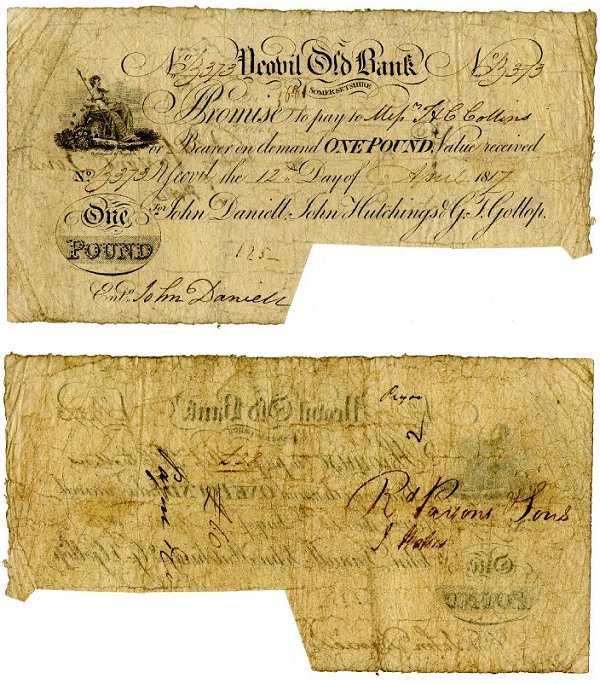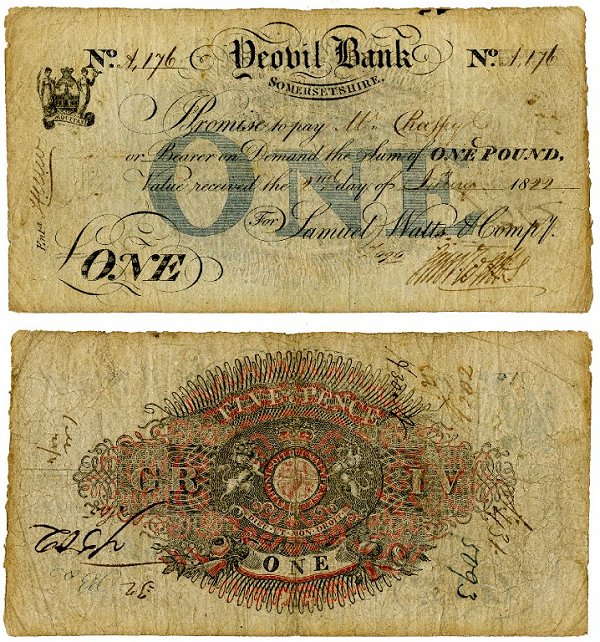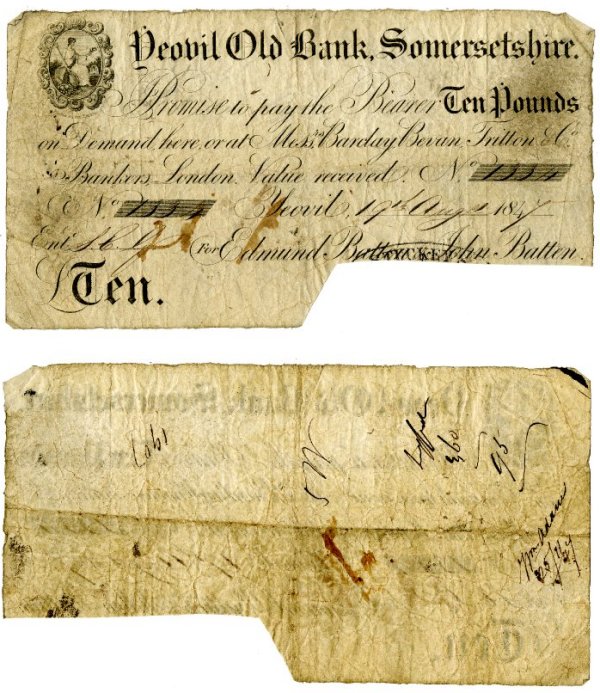yeovil banknotes
yeovil banknotes
Issued by Yeovil's early private banks
During the end of the eighteenth century a number of private banks were established in Yeovil. Private banks were allowed to issue notes but were restricted to six partners or less and each bank issued their own banknotes, examples of which are illustrated below. Far from being ordinary currency as we are used to today, the £1, £5 and £10 notes issued by these banks were not for use in everyday shopping transactions. For example the £1 banknote of Yeovil Old Bank issued in 1813, the first illustration below, would have a value of about £55 at today's value while the last illustrated below, a Yeovil Old Bank £10 note of 1847 would have a value of about £775 at today's value.
The big runs on these private banks occurred in 1825, and new legislation was then introduced.
Yeovil Old Bank was a private bank established by 1774, by Samuel Daniell who was appointed to receive and exchange deficient gold coin.
Yeovil Bank was a private bank established by Yeovil attorney Samuel Watts the Elder. The bank was probably founded around 1810 and was certainly active during the early 1820s. A reference in the London Gazette in 1812 has it Watts Marsh & Co. (Samuel the elder's sons Samuel and Joseph Watts and Thomas Marsh). The Nossiter bankruptcy of 1815 has as one of his creditors Messrs Watts Marsh & Bullock & Co. Later in 1815 it was announced that this banking partnership was dissolved by mutual consent under the signatures of Samuel Watts the Younger, Thomas Marsh, Thomas Bullock, and James Glyde. Daniel Vickery, writing in 1856, referred to Yeovil's third bank as Samuel Joseph Watts and Cayme. By 1822 (Pigot's Directory) it had become Samuel Watts & Co. It would then have gone out of business on 8 November 1823, when Samuel Watts the Younger, scrivener and banker, was declared bankrupt. The Yeovil Bank went down early probably because of the loss of confidence that came with the failure of the Watts and James Cayme the Younger enterprises on Wine Street.
A private bank was established as Henry Whitmash & Richard Brown in Wincanton in about 1796. After several name changes, the bank opened a branch in Yeovil in 1808 and from then it was known as the Yeovil & Wincanton Bank.
Stuckey’s Bank, a joint stock bank and the second to be formed in the country, was created in 1826 by the amalgamation of three Stuckey family banks – Stuckey, Lean, Hart & Maningford of Bristol, S & G Stuckey & Co of Langport and Stuckeys & Woodlands of Bridgwater – along with the private Bristol bank of Ricketts, Thorne & Courtney. It absorbed, among others, Yeovil Old Bank and the Yeovil & Wincanton Bank.
GALLERY

From my
collection
A "cut-cancelled" £1 banknote (worth around £95 at today's value) signed by John Hutchings of the Yeovil Old Bank, dated 27 February 1818. It measures 7½ x 3¾ inches (185 x 95mm).
A "cut-cancelled" banknote refers to a banknote that has been intentionally damaged by having a portion cut out of it, to signify that it is no longer valid for circulation.

©
Trustees of
the British
Museum
The obverse (signed by John Daniell) and reverse of a Yeovil Old Bank £1 note of 1817 (about £60 at today's value). Actual size = 200mm x 108mm.

© Trustees
of the
British
Museum
The obverse of a Yeovil Old Bank £1 note, with a slightly different design, of 1820. Actual size = 182mm x 94mm.

© Trustees of the British Museum
The obverse and reverse of a Yeovil Old Bank £5 note of 1814 (about £290 at today's value). Actual size = 173mm x 87mm.

© Trustees of the British Museum
The obverse and reverse of a Yeovil Old Bank £5 note, printed both sides, of 1838 (about £380 at today's value). The image at the centre id of St John the Baptist and based on the seal of the Borough of Yeovil. Actual size = 195mm x 104mm.

©
Trustees of
the British
Museum
The obverse and reverse of a Yeovil Bank (as opposed to the Yeovil Old Bank) £1 note of 1822 (about £77 at today's value). Actual size = 187mm x 99mm.

A one pound note issued by the Yeovil & Wincanton Bank. Notes were printed in £1, £5, and £20 denominations, but only the £1 and £5 notes are known to have been issued.

©
Trustees of
the British
Museum
The obverse and reverse of a £5 note of the Yeovil & Wincanton Bank featuring an engraving of St John's church. From the period 1808 to 1835, at which time £5 would be worth in excess of £300 at today's value. Actual size = 187mm x 102mm.

© Trustees
of the British
Museum
The obverse of an undated Stuckey's Bank £10 note. Actual size = 206mm x 104mm.

The obverse and reverse of a Yeovil Old Bank £10 note of 1812 (about £560 at today's value). Actual size = 192mm x 104mm.

© Trustees of the British Museum
The obverse and reverse of a Yeovil Old Bank £10 note of 1847 (about £775 at today's value). Actual size = 192mm x 104mm.